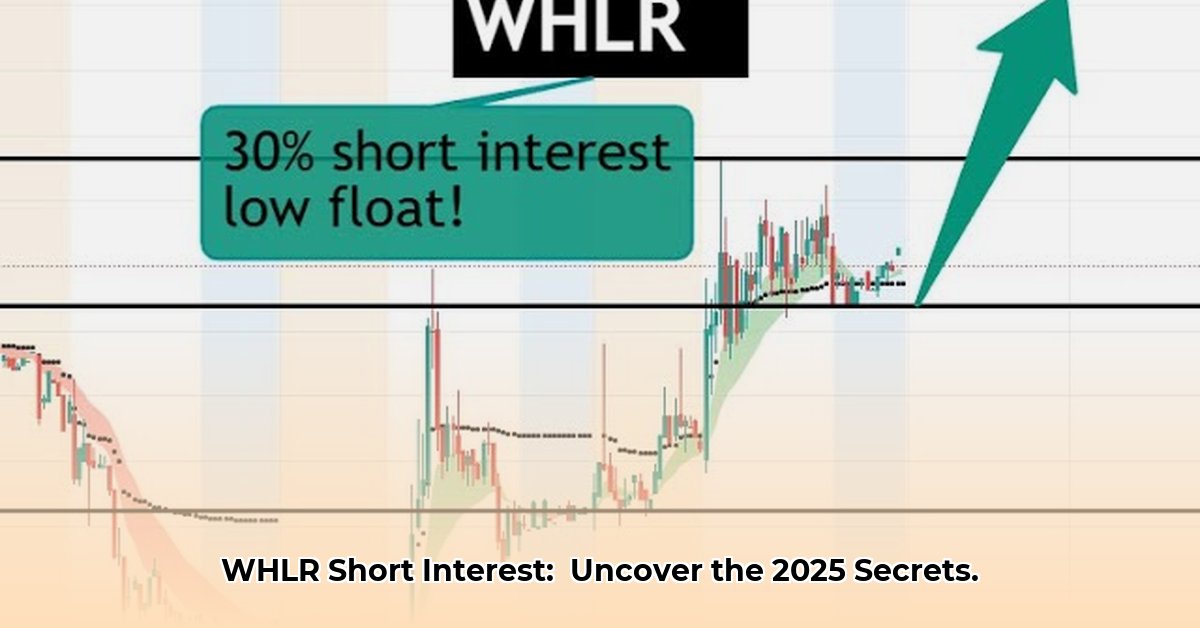
WHLR Short Interest: A Comprehensive Analysis
Understanding short interest—the number of shares sold short (borrowed and sold with the expectation of repurchasing at a lower price)—is crucial for assessing investor sentiment and potential market movements. While a high short interest might suggest negative sentiment towards WHLR, it's vital to remember that it doesn't predict future price movements. A thorough analysis requires considering various factors alongside the short interest data. For further market insights, check out this cryptocurrency analysis.
Decoding WHLR's Short Interest Dynamics
The short interest in WHLR reflects the collective belief of a segment of the market regarding its future trajectory. A significant increase (or decrease) indicates a shift in investor sentiment, potentially influencing price volatility. However, it is imperative to analyze the underlying drivers of these changes rather than solely relying on the short interest figure itself. Does a rise in short interest reflect genuine concerns about WHLR's fundamentals, or is it driven by broader market trends or short-term speculation? Understanding this nuance is critical.
Factors Influencing WHLR's Short Interest
Multiple factors could be driving the current levels of WHLR's short interest. Recent financial performance, particularly earnings reports that fall short of expectations, could trigger a surge in short selling. Negative news coverage or analyst downgrades, if any, could further amplify this sentiment. Conversely, positive news, strong sales figures, or positive analyst upgrades could reduce short interest. Furthermore, broader macroeconomic conditions, such as a general market downturn or increased risk aversion among investors, could trigger increased short selling across the tech sector, impacting WHLR indirectly. Competitive pressures within the technology industry also play a significant role. For instance, the success or failure of competitors like Super Micro Computer could alter market perception of WHLR, impacting short interest levels.
WHLR within the Broader Tech Landscape
WHLR operates within a dynamic and competitive tech landscape. Its performance is intrinsically linked to broader sector trends and the performance of its peers. Market sentiment towards the tech sector as a whole – influenced by factors like macroeconomic conditions, regulatory changes, or investor confidence – significantly impacts WHLR's stock price and consequently, its short interest. Positive advancements in the broader tech sector could improve prospects for WHLR, while negative industry-wide trends could negatively affect its standing, leading to higher short interest.
Analyst Opinions and Divergent Views
Analyst opinions on WHLR vary considerably, reflecting the inherent uncertainty associated with investing in the tech sector. Some analysts may maintain a bullish stance, highlighting WHLR's innovative technology or growth potential. Others could adopt a more cautious or bearish outlook, citing concerns about competition, market saturation, or financial performance challenges. These differing perspectives highlight the complex nature of judging the future of WHLR and contribute significantly to the fluctuations in short interest. It is crucial to examine a wide range of analyst ratings before forming your investment strategy.
Risk Assessment: Navigating the WHLR Investment Terrain
Investing in WHLR, like any stock, carries inherent risks. The high volatility typical of the tech sector, coupled with the potential for short squeezes (rapid price increases driven by short-sellers covering their positions), increases risk. Competitive pressures and the vulnerability to broader market trends further elevate the investment's risk profile. Conducting a thorough assessment of the company's financial statements, analyzing the competitive landscape, and staying abreast of industry news are essential for mitigating potential losses.
Investment Implications: Actionable Strategies
The optimal investment strategy for WHLR depends on an individual's risk tolerance and investment goals. Conservative investors may prefer to avoid highly volatile stocks like WHLR, given the elevated short interest and associated risks. More aggressive investors might see opportunities in a potential short squeeze, depending on their assessment of WHLR's underlying business prospects and long-term potential. However, it's vital to diversify your investments and avoid putting a significant portion of your portfolio into a single stock, especially one with high short interest. A comprehensive risk management plan is crucial.
- Conservative Approach: Diversify your portfolio broadly, avoiding concentrated positions in highly volatile stocks, including WHLR.
- Moderate Approach: Conduct thorough due diligence, monitoring WHLR's news and financial performance, and limiting investment size to a small percentage of your portfolio.
- Aggressive Approach: Carefully evaluate WHLR's fundamentals and competitive landscape. Factor in the complexities of short squeezes and potentially high volatility before considering significant investment.
Key Considerations:
- Market Timing: Attempting to time market fluctuations based solely on short interest data is risky.
- Fundamental Analysis: Evaluate WHLR's financial health and business model alongside market sentiment indicators.
- Risk Management: Diversify your investment portfolio to mitigate potential losses.
Conclusion: A Cautious Approach to WHLR
WHLR's short interest presents a complex picture, requiring a thorough analysis of various factors beyond just the short interest number itself. While potentially lucrative opportunities exist, they are coupled with significant risks. This analysis is for informational purposes only and should not be construed as financial advice. Always conduct thorough due diligence and consider consulting a financial advisor before making any investment decisions. The volatility inherent in the tech sector mandates careful consideration of your personal risk tolerance. Remember, past performance is not indicative of future results.